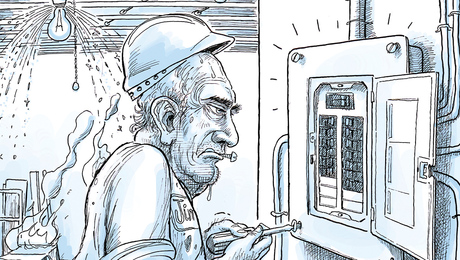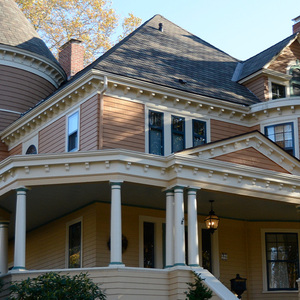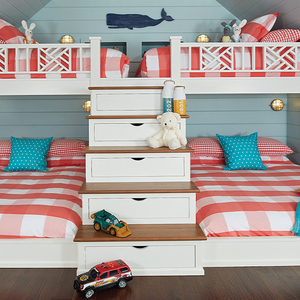I’ve read that insulating interior walls is a good way to deaden sound, and am seeking advice on whether that is true or not.
I am planning on converting a closet into a laundry room. As I’m pretty sure my house does not have its interior walls insulated, should I a.) remove the drywall, insulate the walls and rehang wallboard, b.) build out the walls with 2×2’s or furring strips and insulate the cavity and rehang wallboard, or c.) just not worry about it.
The closet is next to my bedroom, and more importantly, the closet is my wife’s walk-in closet. She is not happy about giving it up, and if I don’t do this right, then I’m sure to hear about. Ultimately, I want to do it right (I read FHB, after all), but I also have a new baby on the way, and I see lots of laundry in my future.
Thanks,
Todd



















Replies
Try these links and search for more on google:
http://www.naima.org/pages/resources/library/pdf/BI405.PDF
http://www.tapinsulation.com/acoustics.html
A good way to deaden sound is to prevent 'resonance' through the solid wall materials.
A standard 2x4 interior wall with wallboard mounted directly to both sides does little to stop sound. It's sort of like a drum. Add insulation between studs, and you will stop some additional sound, particularly 'weaker' high frequencies, but lower frequency sound will still resonate through the solid materials. Think of a car passing with the stereo blasting. What do you hear? Thumpa thud thump boom boom. Just the bass!
Basically, you want an 'air' break between the wall.
You can build a true double wall
Or, you can alternate and offset the studs to take up less space. Drywall for one side mounted on one set of studs, drywall for other side mounted on other set of studs. Offset can be say just 1/2 inch, if needed.
Either way, stuff the cavity with fiberglass batts.
For even better results, you could put a layer of dense homosote (sound deadening board) under the drywall.
Also, seal air gaps between the spaces, since sound obviously travels on air as well.
One of the ultimate sound deadeners, not often seen in residential construction, is thin lead sheeting. Sound waves sort of hit it and then dribble down, not through. We used to have great success with it in boatbuilding.
Formerly BEMW at The High Desert Group LLC
Besides doing the common wall, sound will make an "end run" around it, too. So you should do the side walls and ceiling, too.
If you don't care about appearance you could add those really tacky acoustic tiles to the ceiling too.
The dryer will rumble through the floor (unless you're on a slab). I don't know what to suggest, other than since it's a small space, some of the high end really cushy soft vinyl that's like a quarter inch thick with integral foam backing.
Bruces ides is a valid one. Adding mass to the wall assembly will help reduce sound transmision. I have never used the lead thing other than for X-ray rooms and even then its infrequent. But a layer of 5/8 rock on each side will help you out, that is if you choose not to demo the wall.
Isolation is another good way to reduce transmision. Double framing, alternating 2x4 studs on a 2x6 plate, resiliant channels and so on.
Depending on the type of fiberglass insulation, I would guess that cellulose might give better damping. They do make a special type of fiberglass for accoustical purposes, however.
You might be able to isolate the machines to some extent by putting them on the resiliant foam rubber type matting (or something similar) that is used to reduce fatigue at work benches (or used in wrestling & gymnastic mats). You would need to provide some additional surface area for the corner "feet" of the machines, however, to spread the weight and avoid crushing the mat material.
Just don't forget that thre dryer needs a good source of air. That menas a "hole" to someother part of the house for sound to move through.
_______________________
Why Don't Blind People Like To Sky Dive?
Because it scares the bejabbers out of the dog
Your mileage may vary ....
"She is not happy about giving it up"
You are actually considering taking away your wifes walk-in closet? Are you nuts???
Step away from the tools.
I would rather have my head slammed in a car door.
Lets just say the bungee cord is a little long on this next dive Todd.
Turtleneck
Decoupling the two sides of the wall is a good suggestion for preventing sound transmission, and I did not know about the use of lead sheeting to help deaden sound transmission through walls.
Thank you for all the great ideas.
I live in a 1980's ranch house with the washer and dryer in the kitchen. I wish I were creative enough to blend them into the kitchen floorplan, but I think the limited footprint would force me to place a washer next to the sink. It would be practical, but I really can't adjust to using the dinner table to fold underwear ;)
The advice not to overlook proper venting is a good precaution. Currently, my dryer "vents" into the attached garage. Woohoo! I'm not a construction expert by any means, but I do know what excessive moisture does to drywall and wood.
The washer and dryer are always running at my house, and making a central, quiet spot for them seem like an important part of eliminating clutter and indoor noise pollution.
Thanks!
One suggestion that I didn't see elsewhere in the other posts was to consider upgrading your washer and dryer. There's a big difference in quality and quietness. We replaced our drier recently with a Whirlpool Duet and it's much quieter than our old unit. It was about $800 though, so not cheap. Also, the front loading washers are a lot quieter than the top loaders. A relative has one and you can hardly tell it's running. Check out Consumer Reports on-line if you want to see how they all stack up.
I would not recommend this if you are on a wood framed floor, the front load washers spin so fast and will transmit a lot of vibration through the floor. I don't this in a second floor laundry room in our house and was a bad idea. The mfg recommends they be installed on the first floor on a solid floor, fine home building had a story on this a few issues back.
I've heard of this and then again I've heard several people refute this. Can't say from experience- I just know there's a big difference in noise from different machines. My point is that if someone is concerned about noise, it doesn't make sense to go to great lengths with sound deadening techniques for a $300 washer or dryer (and the original poster may have decent machines- don't really know). It's always best to eliminate any noise source (or reduce it) before trying to contain it.
Edit: The relative whom I spoke of has a front loader in a 50-year old cottage that is hardly over-built (2x6 floor joists probably spanning 10 or 12 feet) and the machine produces no detectable vibration. I suspect it has a lot to do with the level of quality of the machine as much as the floor system.
Edited 10/6/2003 8:10:37 AM ET by stonebm
the front load washers spin so fast and will transmit a lot of vibration through the floor
I haven't seen many, but ran one the other day which didn't have noticeable vibration. It was empty, which could have affected the amount of vibration, of course.
_______________________
Why Don't Blind People Like To Sky Dive?
Because it scares the bejabbers out of the dog
Your mileage may vary ....
Wayne and Bob are cautioning you about venting air into the dryer since you will be confining it to a relatively small or confined space. I am going to assume that the dryer is electric, not gas. You are looking for trouble if you are exhausting the dryer into a garage. Mold and rotten wood in the ceiling or roof decking could be in your future if you can't duct the hot humid air to outside of the house.Do you have a crawl space under the closet? This can be a source of "outside air" for the dryer, and will save money because you will not be using a/c or heated house air. For many houses, every hour of dryer operation will suck out one complete house full of conditioned air, and replace it with outdoor air. It is an energy saver to isolate the washer/dryer in a room with its own source of air,and your wife will notice less dust from lint with good air isolation.If the closet has a supply grille from a central air system, you should close it and seal the grille. Everything the others have advised re sound proofing, will help with room isolation as well. Floor resonance can travel through-out the house, so you want to check its sturdiness. If the floor is wood, you might want to consider wall to wall vinyl with a bead of silicone caulk around the perimeter and across the threshold. A small floor drain to the crawl space(if you have one) will then let your 1/2"deep "pool" drain on the day the fill device fails, or the pump goes, or the water line leaks, rather than flood the house. What do the other posters think about placing the washer and dryer on a/c condenser poly isolation pads? Energy Consultant and author of
Practical Energy Cost Reduction for the Home
Paul - good points, but I'd want to be sure I had a really dry crawl space myself before pulling any air from it.
Also, could you break your stuff into paragraphs, please? It can be really hard to read a really really long paragraph where a lot of thoughts are following each other without break or pause. For the discriminating reader, the relentless onslaught of words, clauses and sentences can be distracting. For the rest of us, a big block paragraph just plain scares the bejabbers out of us, not to mention confusing us even more than the natural state of confusion we already labor under. Some people even think that an overly big blob of words which isn't broken into discreet peices might contain information which could damage our delicate psyches, or even be used to effectively hide weapons of mass destruction from the most relentless of searches by untold thousands of governement minions. Personally, I revel in big, undifferntiated masses of words, particularly if they are woven together into hideously complex senteces, where the subject of the sentence, you know, the thing the sentence is about, which usually, but not invariably appears close to the beginning of the sentence, or, as in the instant case, somewhere in the middle snuck in between a jumble of commas loosely scattered as if by a punctuation randomizer, isn't within shouting distance of the verb of the sentence. Of course, this is a construction site, and some of the people here can't even read, so they probably don't care about the structure, conceptual or physical, of the paragraphs, so long as they aren't fastened together with drywall screws, and some of them they might well think that the bigger the congealed mass of words, the more impressive. Personally, I think life is like a sewer - what you get out of it depends on what you put into it. (Thank you, Tom Lehrer.) The bottom line is, of course, that I'll bet no one actually gets this far into this paragraph but if you, gentle reader, have, in fact, stumbled this far, please use the "send an email feature to let me know and I'll send you the treaditional virtual dog bisquit. Of course, I need to pad out the paragraph some so people don't stumble across that genrous offer when their eyes fatique and slip down to the bottom of the paragraph, so I'll mumble some more about grammer and sentence structure here to throw them off track. {G}
_______________________
Why Don't Blind People Like To Sky Dive?
Because it scares the bejabbers out of the dog
Your mileage may vary ....
Bob, Got your message.
Will use shorter sentenances.
Sometimes my feeble brain tells me to pound out the thought before I forget it.
Like your sky diving line.
PaulEnergy Consultant and author of
Practical Energy Cost Reduction for the Home
Don't forget that you need to treat the door like and exterior one, or everthing you do on the walls will be somewhat wasted. Install foam weatherstripping and put down an adjustable threshold.
Formerly BEMW at The High Desert Group LLC
Careful. Ventilation will be needed for the dryer.